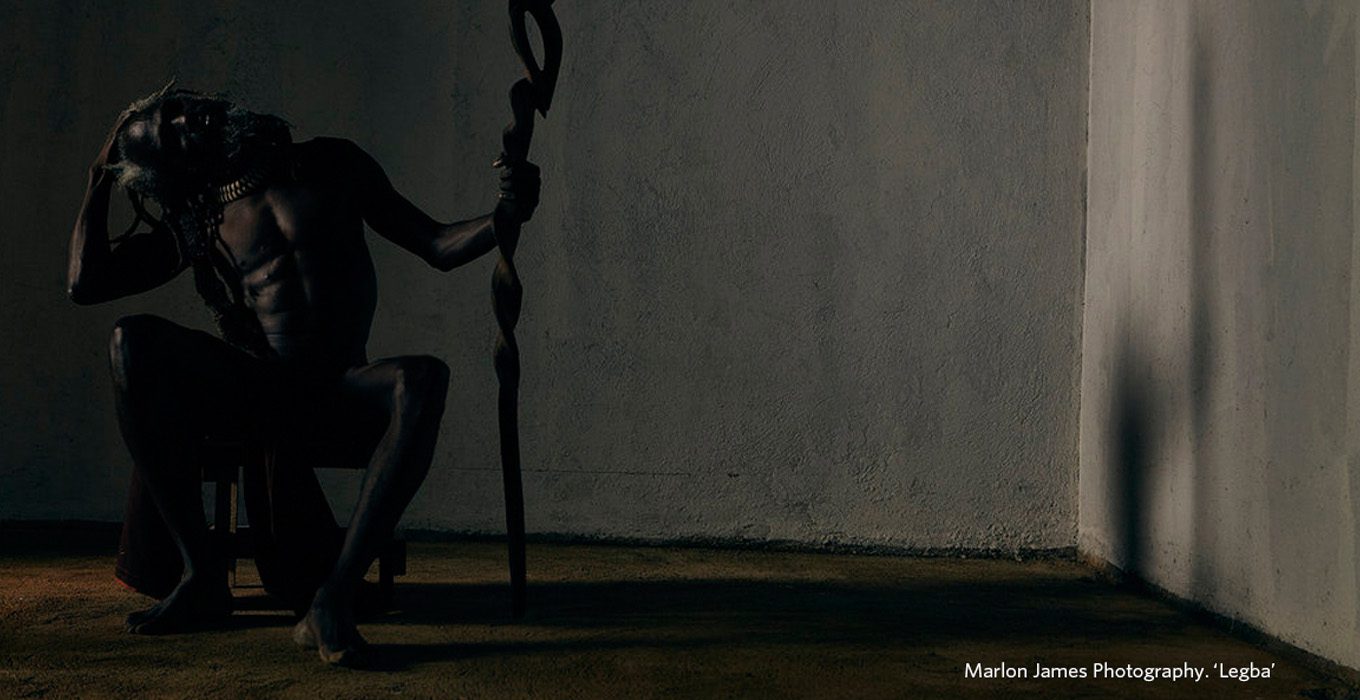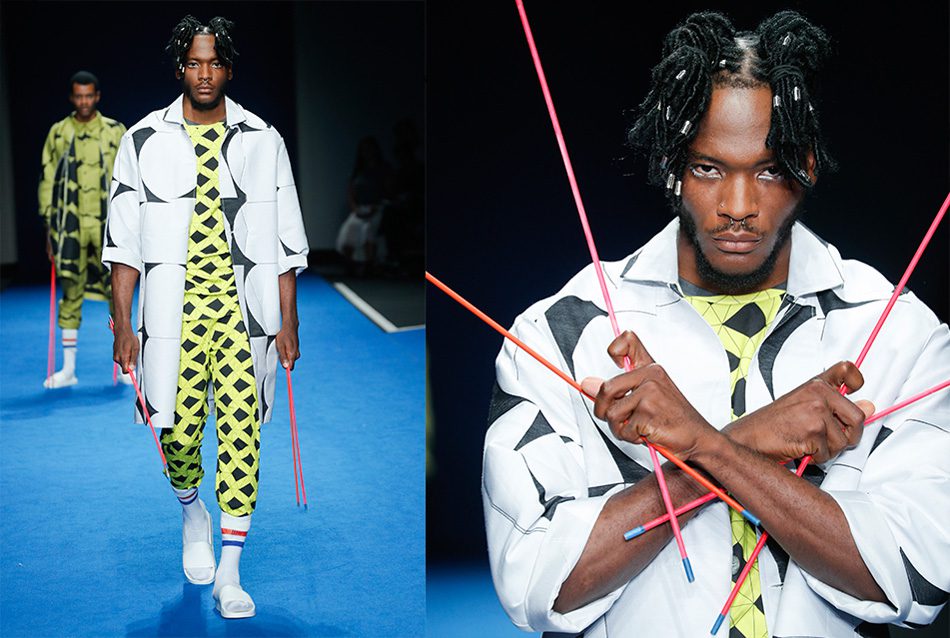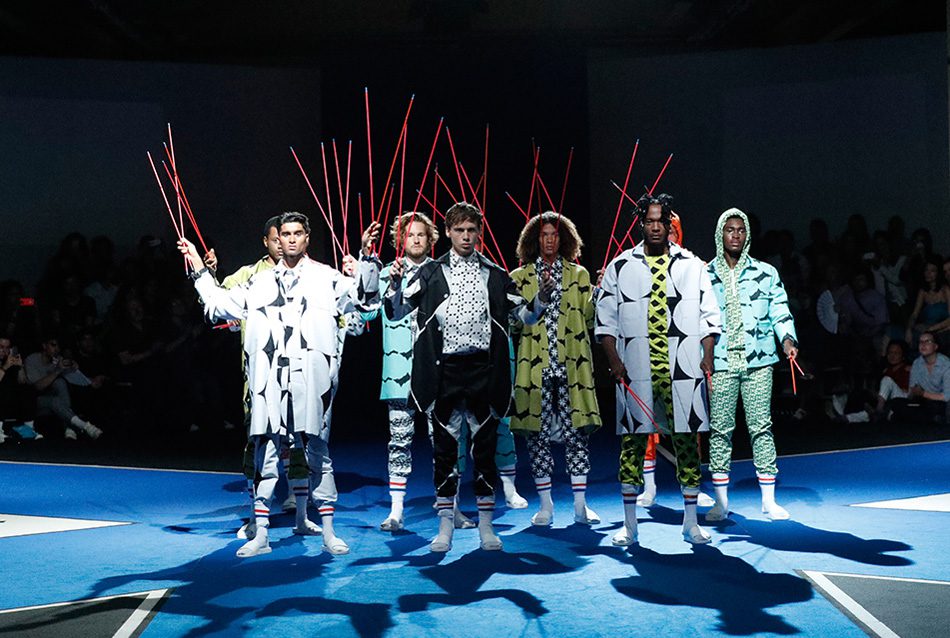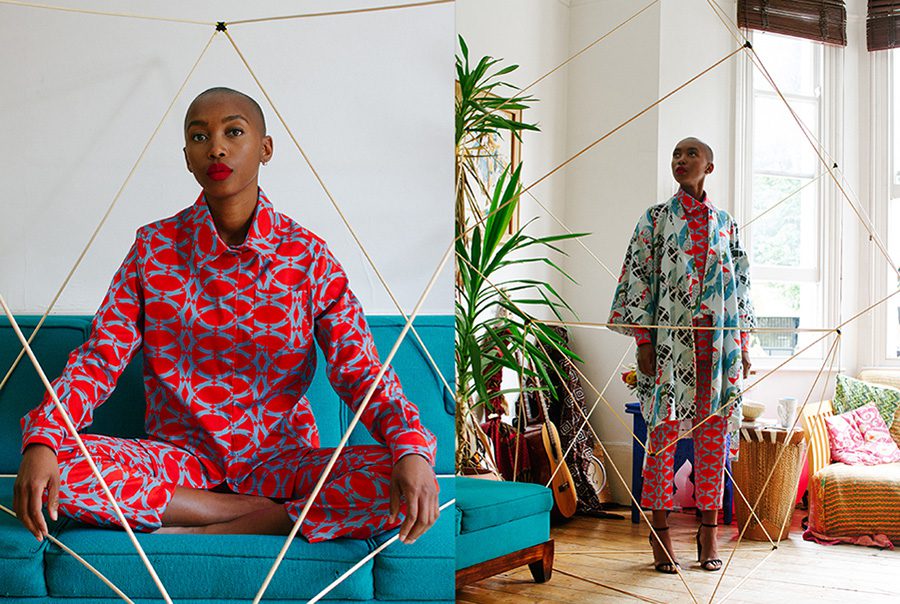

September 20, 2018
Human behaviour and biology. Patterns, cloths and colours. They’re not necessarily groupings that you naturally associate with each other. Which is probably what makes the Enclothed Cognition collection so fascinating. The collaboration is the brainchild of Ulric + Arly’s Mark King and Noir Near Future’s Bregje Cox and explores an interesting space in fashion: how clothes impact our everyday performance and how we feel.
The collection was inspired by the theory of enclothed cognition, which juxtaposes a garment’s meaning with the physical experience of wearing it, and then enriched with elements from the Bajan landscape and scientific principles.
This wasn’t our first chat with Mark but it was our first with the two of them. We hope you enjoy it as much as we did.
Both sides of my family are from Barbados but I was born in Washington DC and then lived in Maryland for the first few years of my life. When I was three, we moved to Barbados and then the Bahamas and then Belgium! I finally moved back to Washington, went to Howard University for undergrad, San Francisco for my M.F.A. in photography and then moved back to Barbados in 2009. I’ve been here ever since.
So you were born in Barbados?
MARK KING: Both sides of my family are from Barbados but I was born in Washington DC and then lived in Maryland for the first few years of my life. When I was three, we moved to Barbados and then the Bahamas and then Belgium! I finally moved back to Washington, went to Howard University for undergrad, San Francisco for my M.F.A. in photography and then moved back to Barbados in 2009. I’ve been here ever since.
Well, that explains your accent, more specifically, your lack of a Caribbean accent! What did your parents do that had you moving around so much?
MARK KING: My father was a career diplomat so that took us most places. San Francisco was a move I made on my own for school.
And what took you back to Barbados?
MARK KING: At the time, I had just completed my M.F.A. My US student visa was about to run out, I’d quit my job in San Francisco and this was at the height of the economic collapse. So I couldn’t get any work and just had to head back to Barbados quite abruptly.
But the move actually ended up being a good thing for me. It took some adjustment but that was when I figured out how to combine photography and art-making. And the local artists I befriended motivated me to take my art more seriously.
So can we jump straight in to your fascination with behavioural psychology and how it affects your work… Can you explain that to me?
MARK KING: At its root, what interests me about behavioural psychology are the patterns: the patterns occurring at the cellular level… Neurons firing in hexagonal lattices… the whole lot! But what has kept me on this path has been an obsession of mine to bring awareness to those patterns that are working in the background guiding our behaviour. I believe that these same patterns can be leveraged for our betterment.
How it further connects is that there are also patterns inspired by the built environment, which are woven into garments. And not just the patterns: the silhouettes of the clothes, the design, how the fabric feels on your skin and what experience that provides the wearer while navigating the built environment.
Now consider how that impacts our experience of the world. There are actual systems that affect our day-to-day lives, which we hardly acknowledge.
I’ve always been intrigued by your work. From your early photography to your pattern and design work and then when you started applying patterns to objects like kitchen fabrics, I thought, “This is really cool!”
Now you have a fashion collection that’s a pattern design and fashion collaboration with a fashion designer in Europe…
MARK KING: I really enjoy exploring different subjects through a wide range of mediums. It gives me the creative freedom to express an idea or a concept as I see fit.
And collaboration allows me to dip my toes in areas like textiles, fashion, home wares, installation and even public art. You get to work with different people and that’s always a lot of fun.
So what drew you to pattern making?
MARK KING: Pattern making allows me to communicate directly with the viewer – it arrests their attention.
The first patterns I know of yours, Mark, are on your Ulric + Arly series of placemats, kitchen towels and napkins. What sparked this interest in creating kitchen items?
MARK KING: What drew me to creating homeware items were my pattern screen printing experiments. That paired with the resources that were available to me in Barbados and my goal of creating work that was both accessible and existed outside of a gallery were also big motivators.
So making your work more accessible to people was an intentional plan?
MARK KING: It just kinda happened that way, and I liked that approach once the textiles made their way into homes. Like the way bold patterns are widely popular, the art pieces became accessible through the leveraging of a familiar medium: textiles. It was functional art. So I guess that’s another reason why I’m into public installation. Because you can walk through it, you can be in the space, and that can inform your mood without having to cross a threshold to experience it.
Let’s dig into Enclothed Cognition and your collaborator Bregje Cox. Where did you two meet and how did the collaboration come to be?
MARK KING: We first met in Brussels through mutual friends. It was February 2011 and I was in town for a screen-printing residency. I’d spend three weeks at the residency and five weeks bouncing between Antwerp, Berlin, Brussels, Paris and London.
Prior to my trip, I had reached out to my friend Desta who has an extensive Brussels network. She gave me this laundry list of people I needed to check out and I ended up hanging with a newly formed collective called the Cut Up Collectif. The group was made up of stylists and designers and makeup artists and we’d work on shoots and collaborations together.
That’s how I met Bregje and that introduction led to Bregje and I coming together on a clothing collection. By then, she had done some pretty big shows already: FASHIONCLASH Festival 2014 and 2016 and Mercedes Benz Amsterdam Fashion Week 2014 and 2015.
Around the same time, I had started incorporating my pattern work into my artwork. I showed Bregje and she came up with the idea of collaborating. The next thing you know, we started the process of developing the collection. It’s been a little over two years now that we’ve been working on Enclothed Cognition.
Bregje, can you tell us a bit about your background?
BREGJE: I was born in the Netherlands, graduated from fashion school in 2009 and have been working for my own brand Noir Near Future ever since.
And what was it about Mark and his work that made you want to collaborate with him?
BREGJE: I think Mark and I both rely heavily on research as the foundation for our work. That’s where I first saw the connection. I love to do extensive research but, at the end of the day, your audience has to connect to your work without getting all of that information. So Mark and I started sharing theories and articles that connected to the enclothed cognition theory and it just grew from there.
I noticed both of you mention science and information in your bios in reference to how you apply your art and design. Was this what clicked and made you both think it could work?
MARK KING: Well, we had this discussion earlier on about patterns, about Bregje’s process and about my research. Once we got into it, we were ‘geeking out’ about what we were both researching and how we felt about patterns and fashion. Soon we were throwing ideas back and forth, sharing sketches, and making prototypes. I would say that once the first prototypes came in, that’s when it really cranked.
So the patterns were the connector?
MARK KING: Definitely because Bregje’s work is also quite pattern centered as well and she’s collaborated with other surface designers in the past. It was nice to connect this concept and build it out. It’s really the result of our interests coming together.
BREGJE: I read a lot of science fiction and what I absolutely love about it is that they’re always envisioning a future in which things are either much worse or much better. The best writers are connected to their environment and the general state of the world and are always incorporating new ideas. I find it so inspirational that people can write about the world in a way that will actually help actualize some of these ideas. So it really helps me as a designer to get into that state of mind and ask myself, “What does the world need at this point? What can I develop? How can I make things better?”
Let’s go back to the process. Tell me how it works. Do you work entirely on your own, as far as working on the patterns and then show them to Bregje?
MARK KING: It’s interesting. When we started, I focused on the patterns and Bregje handled the garment development and creation of the collection. The plan was that we would connect them together but, in practice, it’s closer to a collaboration where roles blur at points.
While my main focus is pattern development, we work together to decide which patterns work within the context of the collection and how to best use them for maximum impact. Bregje might bring up the topic of colour, and say, “Hey, here are some colour swatches and combinations to consider.” And I might make some recommendations regarding the fit.
BREGJE: We took a long time to do research and fine-tune the concept of the collection so we had a very strong base to start from. Mark is always developing new patterns and he would show me what he was working on. I would help chose patterns that would go well with clothing and help find a color scheme that would pull the collection together. We would go back and forth a lot as we both have our own field of expertise but in the end we agreed quite easily about most of the decisions we had to take.
And what do you think you’ve learned throughout this particular process?
MARK KING: The experience has made me a better textile designer for sure. I now have a greater understanding of how patterns can elevate a sartorial concept. This is why collaboration is so important. If Bregje wasn’t there for us to troubleshoot in tandem, it would have taken much longer to make any meaningful headway with respect to developing the prints. She also has a lot of experience developing patterned textiles so I benefited greatly from her insight.
BREGJE: Collaborating on this level feels like a masterclass. I’ve always used patterns and colors to create a feeling but, using Mark’s expertise in working with the relationship between our experiences as human beings and the built environment, I was able to sharpen my own concepts. By adding Mark’s patterns and structures, the clothes were elevated from their purely functional aesthetic. That’s what I loved about the project in the end: you can wear these clothes because you love the fit or the colour or the pattern but once they pop back into Mark’s environments, the whole concept changes again.
What’s a fashion procession?
MARK KIING: It’s a procession of models, in this case ten models wearing garments inspired by Catholic liturgical robes. We were one of ten designers invited to create a piece for the procession so we designed a jacquard woven hybrid kimono in our Augmentation olive print. The kimono then went on view at the Bonnefantenmuseum next to the Catholic liturgical robe that inspired its creation.
I saw the final pieces on Instagram and they’re stunning. Very bold! What was the feedback like?
BOTH: Thank you so much! The feedback has been great and a lot of people are contacting us to find out how they can purchase pieces from the collection. Thanks to our participation in FASHIONCLASH, we’ve received coverage from Micro Macro Magazine, Fucking Young Magazine and Vogue Italia.
We also had MINDFASHION reach out to us with some excellent feedback and support. They’re doing amazing work within the field of psychology and fashion with a focus on the future of design. We have a lot of people from different countries and backgrounds connecting to the pieces either because of the patterns or the colours or the cut. We can’t wait to release some pieces and see what life they will take on.
So, Bregje, have you been to Barbados before? Or any other parts of the Caribbean?
BREGJE: Not yet! And this is definitely a huge mistake on my part. After collaborating with Mark and meeting other Bajans, I’m convinced that Barbados is filled with amazing people! I’d love to visit in the future and do a shoot with Mark in the locations that have inspired some of these patterns to really make this collaboration come full circle.




INTERVIEWER: TANYA MARIE. photography courtesy Enclothed Cognition